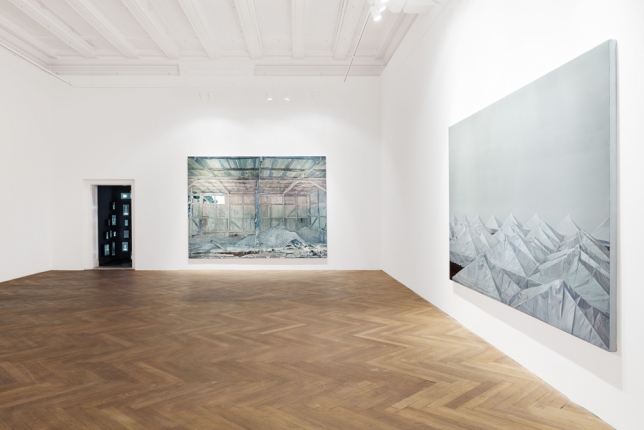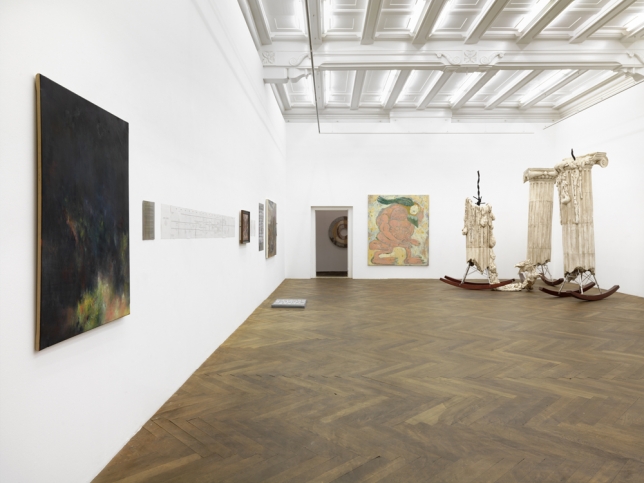NONA GARCIA
UNEARTH
Solo exhibition at ARNDT Berlin
February 13 - March 14, 2015
Opening | Friday | February 13, 2015 from 6 - 9 pm | at ARNDT Berlin
ARNDT is pleased to present the first exhibition of Nona Garcia in Berlin.
Although representation is key in Nona Garcia’s art of stark realism, there are always moments when looking at her work involves confrontation with what is hidden, a bout with the indecipherable essence of things. From the illuminated films of sacred icons in her light boxes to portraits of sitters with their backs turned in her previous series of paintings, Nona Garcia’s realism is neither simple depiction of an overwhelming atmosphere nor the combination of particulars, but rather a piercing search for the essence of reality through isolation and intervention, through composition and elimination across objects inside the frame, or through mediation with a device such as an X-ray machine.
For her new set of works to be shown in Arndt Gallery in Berlin, Nona Garcia employs her usual strategy of mounting together paintings that convey her condition and negotiation against her immediate reality—in this case, finding herself in a new environment while being an artist and maker of images. Having recently relocated from the capital region of Metro Manila to the mountaintop city of Baguio in Benguet Province, Philippines, Nona Garcia is bound to interact not only with the highlanders’ culture, but also with the implications of a new visual realm that will soon pervade her waking life: the long mountain ranges of the Cordilleras, the mountaintop settlements along limestone mining towns, and the proximity of clouds wandering across a nearby summit.
The sudden change in vista imposes a remarkable impression to the senses. It is the impression, which nature forces into our own nature—of being human. It is the same reason why throughout art’s history we are treated with a multitude of depictions of landscapes: mountain ranges, treacherous slopes, and vast forests. They fit the characteristics of the sublime, which many philosophers have tried to reconcile as an aesthetic derived from both pleasure and danger. In Nona Garcia’s new set of paintings, though, we do not experience the realization of this genre but the appropriation of a genre. It ceases to become the representation of forms but the application and study of forms. Through her virtuosity in painting, an attribute she has exemplified throughout her career, the idea of landscape is again rendered through painstaking realism that draws us closer to what is represented, but yet again, only to undermine our ideas about what ‘landscape’ is.
Each component in her painting follows a form: the crest found in the structure of mountains. It is its essential attribute—the formation from base to apex. Whether these are images of sloping mounds of sand deposits inside a limestone shed, ranges of raised tents, an array of cement houses across the slope, or a piece of sky, these structures signify the shape of an enigmatic terrain. In a small, dark room inside the gallery, Garcia’s light boxes share this mountain-like formation. Each box shows an illuminated film of sacred relics, which went through the scanner of a clinical X-ray machine. These relics were part of the culture of the mountain region’s indigenous tribes, and their dissected, scientifically drawn images become more mythical and radiant than their wooden actuality. This installation sums up Nona Garcia’s probe into her adopted surroundings, and solidifies her enquiry, and cold, objective look at what lies beneath the surface of venerated things—that their substances, their crude essences are more dumbfounding. Like sacred relics, mountaintops and vestal landscapes can generate awe. In Nona Garcia’s paintings, they turn into banal, desolate objects, but reveal more mystery than any vestal rendition of sunset and valley.
Nona Garcia (b. 1978, Manila) received a Bachelor of Fine Arts in Painting at the University of the Philippines. Solo shows include: Recovery, Bencab Museum, Baguio City (2014), Before the sea, West Gallery, Manila (2012), False Apparitions, Valentine Fine Art, Singapore (2012) or Somewhere Else, Finale Art File, Makati City, Manila (2012). Garcia has also participated in numerous exhibitions in China, Italy, Philippines, Malaysia, Thailand, Singapore, Korea and Japan. In 2003 she was a recipient of the 13 Artists Award and in 2000, Garica was the grand prize winner of the Philip Morris Group of Companies ASEAN (Association of Southeast Asian Nations) Art Award in Singapore.
ARNDT Berlin
Potsdamer Strasse 96
10785 Berlin
info@arndtberlin.com

















